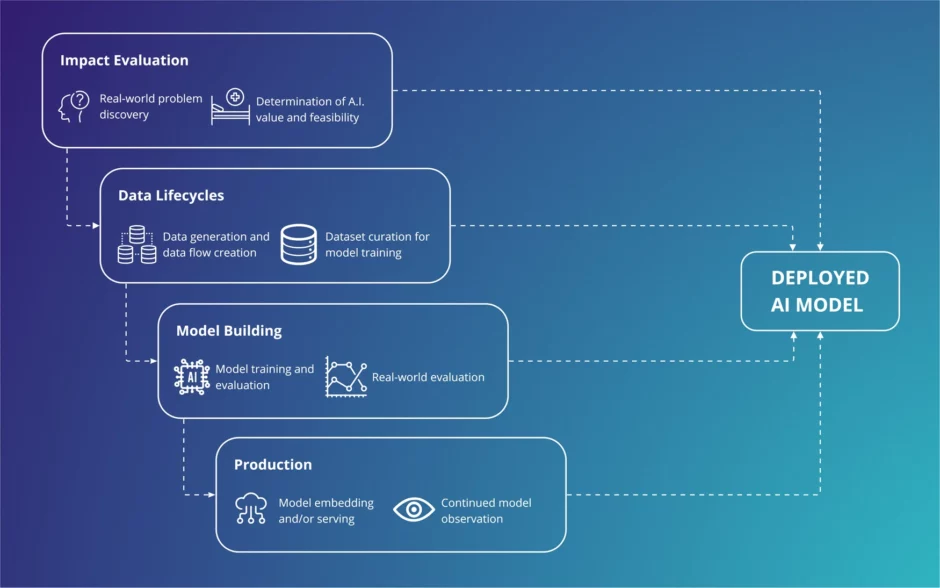Vertically integrated artificial intelligence (AI) development model, which breaks down the traditional barriers between different supply chain components, aiming for a more streamlined and cohesive approach. The model is structured in layers, each representing a critical phase of AI development and deployment, allowing for better end-to-end integration from problem discovery to model deployment. Below, we’ll explore each layer in detail:
1. Impact Evaluation
The first step in this vertically integrated approach is Impact Evaluation. This phase focuses on two key activities:
- Real-world problem discovery: In the initial stage, AI developers and stakeholders identify the real-world problems that need to be solved. This is an essential phase because the value of AI systems lies in their ability to address specific challenges within industries, markets, or research areas. Effective problem discovery requires collaboration between domain experts and AI specialists to ensure the problem is well-defined and worth solving.
- Determination of AI value and feasibility: Once a problem is discovered, the next task is to assess whether AI can provide value as a solution and to analyze the feasibility of developing and implementing the AI model. This step involves considering the technical constraints, availability of data, and the potential return on investment (ROI) that AI might offer. Not every problem will be solvable by AI, and this evaluation helps decide if AI is the right tool or if alternative methods should be considered.
This phase is critical for ensuring resources are not wasted on non-viable projects and aligns the AI development process with clear business or societal goals.
2. Data Lifecycles
After determining that AI is a viable solution, the next phase involves working with the Data Lifecycles. Data is the backbone of AI systems, and this stage addresses two crucial tasks:
- Data generation and data flow creation: At this point, data scientists generate or collect relevant data from various sources. Data generation could involve using sensors, manual data entry, web scraping, or leveraging existing datasets. Data flow creation involves the process of establishing pipelines to ensure that data is continuously fed into the AI model during development and operational stages.
- Dataset curation for model training: Once data is generated, it needs to be curated for training the AI model. This step involves cleaning, organizing, and structuring the data to make it suitable for the machine learning (ML) algorithms. Dataset curation is vital because the quality of data directly impacts the accuracy and performance of the AI model. Biases in data, missing values, or noise can negatively affect the model’s effectiveness, making this a meticulous yet necessary step.
The Data Lifecycle phase ensures that the AI model has a steady stream of high-quality data to learn from, allowing it to be trained to solve the identified problem.
3. Model Building
The third phase in vertical AI development is Model Building, where the AI system is actually constructed and tested. This phase is split into two primary activities:
- Model training and evaluation: In this stage, data scientists and ML engineers select algorithms, define the model architecture, and train the model using the curated dataset from the previous stage. Training involves optimizing the model’s parameters using techniques like supervised learning, unsupervised learning, or reinforcement learning. Evaluation of the model is conducted throughout the training process to determine how well it is performing. Metrics such as accuracy, precision, recall, and others are used to assess the model’s performance on training and validation datasets.
- Real-world evaluation: Once the model shows promise in the training environment, it is then evaluated on real-world data. This is an important step because AI models often perform well in controlled environments but fail when exposed to real-world conditions where data is more varied and less predictable. Real-world evaluation allows the team to identify any gaps or shortcomings in the model’s generalizability, ensuring that it performs well outside the lab.
The goal of this phase is to create a well-performing AI model that can not only make accurate predictions in a test environment but also provide value in real-world applications.
4. Production
After building and evaluating the AI model, the final phase is Production, where the AI is integrated into real-world systems. There are two main components to this phase:
- Model embedding and/or serving: In this phase, the AI model is embedded into software applications, deployed on servers, or made accessible through APIs for real-time or batch processing. Model embedding involves integrating the AI model into larger operational systems, while model serving is about deploying the AI for use by other systems or users, ensuring that it can handle requests or make predictions in real-time or on-demand.
- Continued model observation: AI models deployed in the real world require constant observation and maintenance to ensure they continue to perform well over time. External factors, such as data drift, changes in user behaviour, or evolving real-world conditions, can degrade model performance. Continued model observation includes monitoring key performance indicators (KPIs) and model retraining if necessary to ensure the AI system adapts to new circumstances and remains accurate and reliable.
Deployed AI Model
After completing all these phases, the AI model is fully deployed. At this point, it is integrated into the operational workflow or business process, and it can begin delivering value. The deployed model often continues to be monitored and retrained as needed to adapt to new data or changing conditions, ensuring its longevity and continued efficacy.
Vertical Integration Concept
The key takeaway from this model is vertical integration. Traditionally, AI development processes are siloed, with different teams handling problem definition, data collection, model training, and deployment in separate phases with little interaction. Vertical integration seeks to break down these barriers by creating a continuous, interconnected process where all phases of AI development communicate and interact with each other.
By ensuring seamless integration between all these components—problem discovery, data management, model training, and deployment—the vertical integration model allows AI systems to be developed more efficiently and effectively. Feedback loops between different phases ensure that any issues or improvements can be addressed earlier in the process, reducing the time and resources wasted on rework.
Conclusion
This vertically integrated AI development model represents a more streamlined, efficient way to create and deploy AI solutions. By fostering closer communication and collaboration between all phases of development, AI systems are more likely to solve real-world problems effectively and remain valuable over time. This method also emphasizes the importance of continuous improvement, as AI models require ongoing monitoring and adaptation to perform well in dynamic, real-world environments.
The vertical integration framework described here not only highlights the importance of aligning AI solutions with real-world needs but also suggests a way forward for more scalable, adaptable AI development, where barriers between various phases of the process are systematically broken down for better overall outcomes.
References:
- Zhang, J. et al. (2022). “Moving towards vertically integrated artificial intelligence development.” Nature Digital.
URL: https://www.nature.com/articles/d41586-022-00001-1 - Goodfellow, I., Bengio, Y., Courville, A. (2016). “Deep Learning.” MIT Press.
URL: https://www.deeplearningbook.org/ - Jordan, M. I., Mitchell, T. M. (2015). “Machine learning: Trends, perspectives, and prospects.” Science, 349(6245), 255-260.
URL: https://www.science.org/doi/10.1126/science.aaa8415 - Russell, S., Norvig, P. (2020). “Artificial Intelligence: A Modern Approach.” 4th Edition, Pearson.
URL: https://www.pearson.com/store/p/artificial-intelligence-a-modern-approach/P100000866596 - Sculley, D. et al. (2015). “Hidden Technical Debt in Machine Learning Systems.” NeurIPS Conference.
URL: https://papers.nips.cc/paper/5656-hidden-technical-debt-in-machine-learning-systems.pdf - Amodei, D. et al. (2016). “Concrete Problems in AI Safety.” arXiv Preprint.
URL: https://arxiv.org/abs/1606.06565 - Halevy, A., Norvig, P., Pereira, F. (2009). “The Unreasonable Effectiveness of Data.” IEEE Intelligent Systems.
URL: https://ai.google/research/pubs/pub35179 - Varshney, K. R., Alemzadeh, H. (2017). “On the Safety of Machine Learning: Cyber-Physical Systems, Decision Sciences, and Data Products.” Big Data, 5(3), 246-255.
URL: https://www.liebertpub.com/doi/full/10.1089/big.2016.0061








